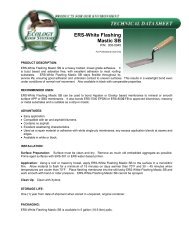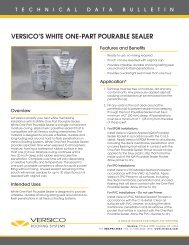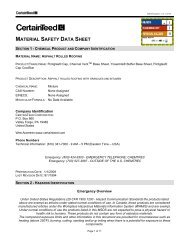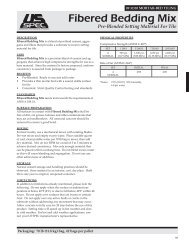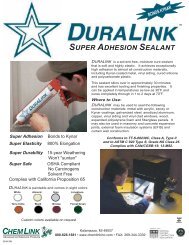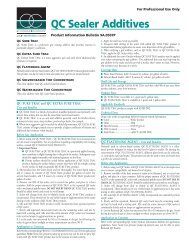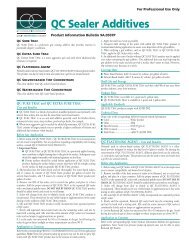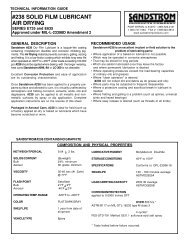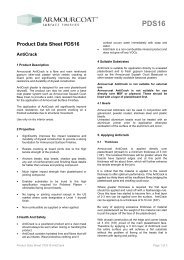Simpson Anchors - Anchoring and Fastening Systems - BuildSite.com
Simpson Anchors - Anchoring and Fastening Systems - BuildSite.com
Simpson Anchors - Anchoring and Fastening Systems - BuildSite.com
Create successful ePaper yourself
Turn your PDF publications into a flip-book with our unique Google optimized e-Paper software.
C-SAS-2009 © 2009 SIMPSON STRONG-TIE COMPANY INC.<br />
IMPORTANT INFORMATION AND GENERAL NOTES<br />
These general instructions for the designer are provided to ensure the<br />
proper selection <strong>and</strong> installation of <strong>Simpson</strong> Strong-Tie Company Inc.<br />
products <strong>and</strong> must be followed carefully. These general instructions are in<br />
addition to the specifi c design <strong>and</strong> installation instructions <strong>and</strong> notes provided<br />
for each particular product, all of which should be consulted prior to <strong>and</strong><br />
during the design process.<br />
a) The term “Designer” used throughout this catalog is intended to mean<br />
a licensed/certifi ed building design professional, a licensed professional<br />
engineer, or a licensed architect.<br />
b) All connected members <strong>and</strong> related elements shall be designed by the<br />
Designer <strong>and</strong> must have suffi cient strength (bending, shear, etc) to<br />
resist the loads imposed by the anchors.<br />
c) When the allowable stress design method is used, the design service<br />
loads shall not exceed the published allowable loads.<br />
d) When the ultimate strength design method is used, the factored loads<br />
shall not exceed the design strengths calculated in accordance with the<br />
published design data.<br />
e) <strong>Simpson</strong> Strong-Tie ® strongly re<strong>com</strong>mends the following addition<br />
to construction drawings <strong>and</strong> specifi cations: “<strong>Simpson</strong> Strong-Tie<br />
products are specifi cally required to meet the structural calculations of<br />
plan. Before substituting another br<strong>and</strong>, confi rm load capacity based on<br />
reliable published testing data or calculations. The Engineer/Designer of<br />
Record should evaluate <strong>and</strong> give written approval for substitution prior<br />
to installation.”<br />
f) Local <strong>and</strong>/or regional building codes may require meeting special<br />
conditions. Building codes often require special inspections of<br />
anchors installed in concrete or masonry. For <strong>com</strong>pliance with these<br />
requirements, it is necessary to contact the local <strong>and</strong>/or regional<br />
building authority. Except where m<strong>and</strong>ated by code, <strong>Simpson</strong><br />
Strong-Tie ® products do not require special inspection.<br />
g) Allowable loads <strong>and</strong> design strengths are determined from test results,<br />
calculations, <strong>and</strong> experience. These are guide values for sound base<br />
materials with known properties. Due to variation in base materials<br />
<strong>and</strong> site conditions, site-specifi c testing should be conducted if exact<br />
performance in a specifi c base material at a specifi c site must be<br />
known.<br />
h) Unless stated otherwise, tests conducted to derive performance<br />
information were performed in members with minimum thickness<br />
equal to 1.5 times the anchor embedment depth. <strong>Anchoring</strong> into thinner<br />
members requires the evaluation <strong>and</strong> judgment of a qualifi ed Designer.<br />
i) Tests are conducted with anchors installed perpendicular (±6°) to the<br />
surface of the base material. Deviations can result in anchor bending<br />
stresses <strong>and</strong> reduce the load carrying capacity of the anchor.<br />
j) Allowable loads <strong>and</strong> design strengths do not consider bending stresses<br />
due to shear loads applied with large eccentricities.<br />
SUPPLEMENTAL TOPICS FOR ANCHORS<br />
GENERAL<br />
G1. Base Materials<br />
"Base material" is a generic industry term that refers to the element or<br />
substrate to be anchored to. Base materials include concrete, brick, concrete<br />
block (CMU) <strong>and</strong> structural tile, to name a few. The base material will<br />
determine the type of fastener for the application. The most <strong>com</strong>mon type of<br />
base material where adhesive <strong>and</strong> mechanical anchors are used is concrete.<br />
Concrete – Concrete can be cast in place or precast concrete. Concrete has<br />
excellent <strong>com</strong>pressive strength, but relatively low tensile strength. Cast-inplace<br />
(or sometimes called "poured in place") concrete is placed in forms<br />
erected on the building site. Cast-in-place concrete can be either normalweight<br />
or lightweight concrete. Lightweight concrete is specifi ed when it is<br />
desirable to reduce the weight of the building structure.<br />
GENERAL INSTRUCTIONS FOR THE DESIGNER<br />
k) Metal anchors <strong>and</strong> fasteners will corrode <strong>and</strong> may lose load-carrying<br />
capacity when installed in corrosive environments or exposed to<br />
corrosive materials. See Supplemental Topic G3.<br />
l) Mechanical anchors should not be installed into concrete that is<br />
less than 7 days old. The allowable loads <strong>and</strong> design strengths of<br />
mechanical anchors that are installed into concrete less than 28 days<br />
old should be based on the actual <strong>com</strong>pressive strength of the concrete<br />
at the time of installation.<br />
m) Nominal embedment depth (embedment depth) is the distance from<br />
the surface of the base material to the installed end of the anchor <strong>and</strong><br />
is measured prior to application of an installation torgue (if applicable).<br />
Effective embedment depth is the distance from the surface of the base<br />
material to the deepest point at which the load is transferred to the base<br />
material.<br />
n) Drill bits shall meet the diameter requirements of ANSI B212.15. For<br />
adhesive anchor installations in oversized holes, see Supplemental<br />
Topic A1. For adhesive anchor installations into core-drilled holes, see<br />
Supplemental Topic A2.<br />
o) Threaded-rod inserts for adhesive anchors shall be UNC fully threaded<br />
steel.<br />
p) Allowable loads <strong>and</strong> design strengths are generally based on testing of<br />
adhesive anchors installed into dry holes. For installations in damp, wet<br />
<strong>and</strong> submerged environments, see Supplemental Topic A3.<br />
q) Adhesive anchors should not be installed into concrete that is less<br />
than 7 days old. The allowable loads <strong>and</strong> design strengths of adhesive<br />
anchors that are installed into concrete less than 28 days old should be<br />
based on the actual <strong>com</strong>pressive strength of the concrete at the time<br />
load is applied.<br />
r) Adhesive anchors can be affected by elevated base material<br />
temperature. See Supplemental Topic A4.<br />
s) <strong>Anchors</strong> are permitted to support fi re-resistive construction provided at<br />
least one of the following conditions is fulfi lled: a) <strong>Anchors</strong> are used to<br />
resist wind or seismic forces only. b) <strong>Anchors</strong> that support gravity loadbearing<br />
structural elements are within a fi re-resistance-rated envelope<br />
or a fi re-resistance-rated membrane, are protected by approved fi reresistance<br />
rated materials, or have been evaluated for resistance to fi re<br />
exposure in accordance with recognized st<strong>and</strong>ards. c) <strong>Anchors</strong> are used<br />
to support nonstructural elements.<br />
t) Some adhesives are not qualifi ed for resisting long-term sustained<br />
loads. These adhesives are for resisting short-term loads such as wind<br />
or seismic loads only. See Supplemental Topic A5.<br />
u) Exposure to some chemicals may degrade the bond strength of<br />
adhesive anchors. Refer to the product description for chemical<br />
resistance information. Information is also available in <strong>Simpson</strong><br />
Strong-Tie Company Inc. Technical Bulletin T-SAS-CHEMRES.<br />
Lightweight concrete differs from normal-weight concrete by the weight of<br />
aggregate used in the mixture. Normal-weight concrete has a unit weight of<br />
approximately 150 pounds per cubic foot <strong>com</strong>pared to approximately 115<br />
pounds per cubic foot for lightweight concrete.<br />
The type of aggregate used in concrete can affect the tension capacity of an<br />
adhesive anchor. Presently, the relationship between aggregate properties <strong>and</strong><br />
anchor performance is not well understood. A recent study based on a limited<br />
test program has shown that in relative terms, concrete with harder <strong>and</strong> more<br />
dense aggregates tend to yield greater anchor tension capacities. Conversely,<br />
use of softer, less dense aggregates tends to result in lower anchor tension<br />
capacities. Research in this area is ongoing. Test results should not be<br />
assumed to be representative of expected performance in all types of<br />
concrete aggregate.<br />
13



